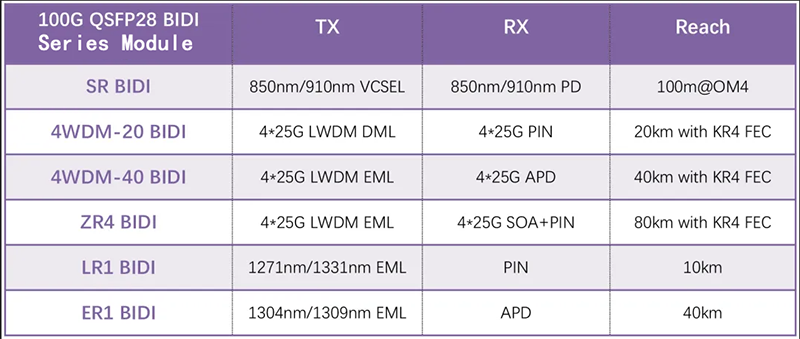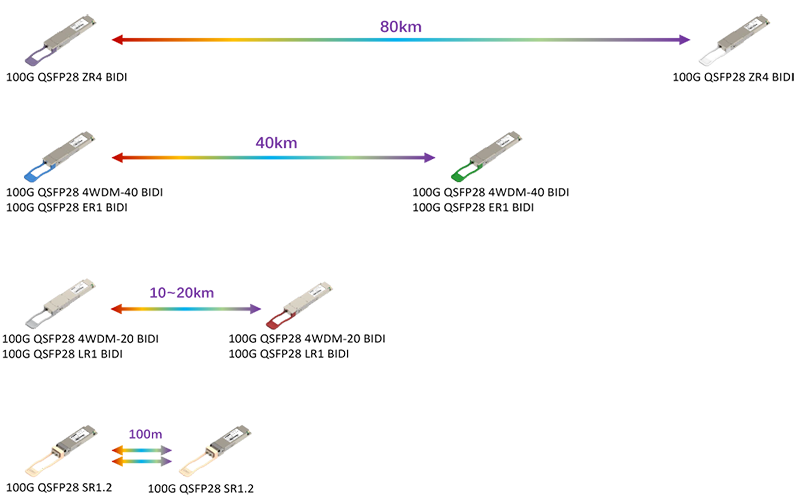

 Knowledge Base +
Knowledge Base +  2024.04.12
2024.04.12To meet the demand for long-distance transmission in scenarios where optical fiber resources are scarce in edge access networks, Walsun has launched the 100G QSFP28 ZR4 BIDI product, and will demonstrate 100G 80km single-fiber bidirectional service transmission at OFC 2024. This is another industry-first product launch by Walsun following the market recognition of its 100G QSFP28 4WDM-20 BIDI industrial-grade optical module in 2020.
The 100G QSFP28 ZR4 BIDI product released by Walsun this time adopts the 4*25G NRZ scheme to achieve single-fiber bidirectional transmission. The overall design maintains consistency with the previous 100G 4WDM-20 BIDI product, which can fully utilize the existing mature high-end manufacturing process platform to ensure stable product delivery. The transmission end of the 100G ZR4 BIDI optical module adopts a high-performance EML chip, and the receiving end adopts a high-sensitivity integrated solution. It can achieve 80km link transmission in KR4 FEC mode, and supports industrial-grade temperature, with module power consumption less than 6.5W.


Walsun 100G QSFP28 BIDI series optical module products
100G QSFP28 SR BIDI module, targeting short-distance applications in enterprise network parks and data centers, can maximize the use of existing cable resources and achieve 40G to 100G network architecture upgrades. It has 2 independent full-duplex optical channels, where a single channel converts two 25G NRZ electrical signals into a single 50G PAM4 optical signal. Its maximum power consumption is 4W, supporting commercial temperature applications, with the farthest transmission distance being 100m@OM4.
100G QSFP28 BIDI long-distance series modules, suitable for long-distance, low-latency transmission, and applications where optical fiber resources are scarce. They can meet the needs of interconnection between cities or remote villages, connections between regional data centers and edge data centers, interconnection between different park data centers within enterprises, and the interconnection of 5G convergence rooms to core routing, etc.
100G QSFP28 ZR4 BIDI module, with mature architecture of 4*25G NRZ on both the electrical and optical sides, fully compatible with existing network equipment interfaces. The O-band wavelength range reduces the dispersion effect of long-distance transmission, SOA integration technology compensates for the optical signal at the receiving end, high-power lasers improve the quality of the transmitted signal, and built-in WDM multiplexing/demultiplexing technology ultimately achieves 80km long-distance single-fiber bidirectional transmission.
Generic QSFP-100G-ZR4 100GBASE-ZR4 QSFP28 Optical Transceiver Module (SMF, 1310nm, 80km, LC, DDM)
QSFP-100G-ZR4 optical transceiver module is designed with duplex LC connectors, reaching a link up to 80km over single-mode fiber(OS2). Walsun manufactured 100GBASE-ZR4 QSFP28 transceiver module is compliant with QSFP28 MSA Compliant standard. Besides, DDM (digital diagnostics monitoring) function is supported on the 100G fiber optic transceiver to achieve real-time operating parameters monitoring. With these features, this 100G QSFP28 transceiver is widely applied in 100G telecom connections, DCI, metro network, long-haul, and high-performance computing networks application.
Part Number: | QSFP28-100G-ZR4 | Vendor Name: | Walsun |
Form Factor: | QSFP28 | Data Rate: | 103.125Gbps (4x 25.78Gbps) |
Wavelength: | 1295~1310nm | Distance: | 80km@G.652 |
Connector: | Duplex LC | Cable Type: | OS2 SMF |
Transmitter: | EML | Receiver Type: | SOA/PIN |
TX Power: | +2 ~ +7dBm | Receiver Sensitivity: | <-27dBm |
Power Consumption: | ≤5.5W | Modulation Format: | NRZ |
DDM: | Support | Bit Error Ratio (BER): | 5E-5 |
Protocols: | QSFP28 MSA, SFF-8636 | Warranty: | 3 Years |
The full range of Walsun 100G QSFP28 BIDI modules will help customers improve network transmission efficiency, increase fiber utilization, reduce network deployment costs, decrease operation and maintenance expenses, and continuously create value for customers.
Subscribe to the newsletter
for all the latest updates.
2-5# Building, Tongfuyu Industrial Zone, Aiqun Road, Shiyan Street, Baoan District, Shenzhen. China
